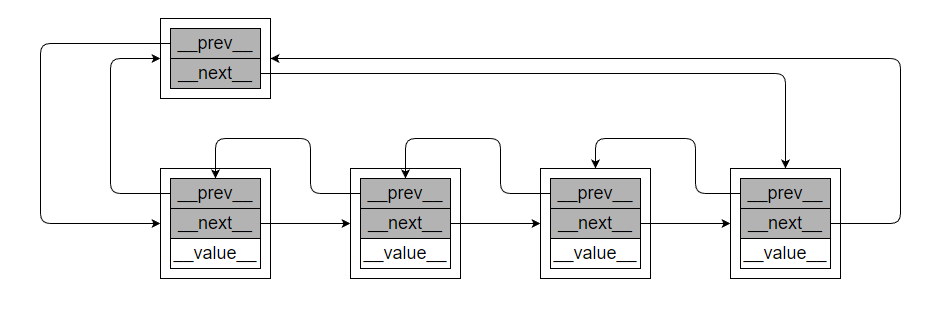前言:之前看过侯老师的《STL源码剖析》但是那已经是多年以前的,现在工作中有时候查问题和崩溃都需要了解实际工作中使用到的STL的实现。因此计划把STL的源码再过一遍。
摘要:本文描述了llvm中libcxx的list的实现。
关键字:list
其他:参考代码LLVM-libcxx
注意:参考代码时llvm的实现,与gnu和msvc的实现都有区别。
list是STL提供的双向链表,可以在头和尾部操作元素。

1 节点
和forward_list一样,list针对索引和节点进行了区分,索引只包含对应访问节点的指针,而节点同时包含链接的指针和数据成员。
template <class _Tp, class _VoidPtr>
struct __list_node_base{
typedef __list_node_pointer_traits<_Tp, _VoidPtr> _NodeTraits;
typedef typename _NodeTraits::__link_pointer __link_pointer;
__link_pointer __prev_; //前向指针
__link_pointer __next_; //后向指针
};
template <class _Tp, class _VoidPtr>
struct _LIBCPP_STANDALONE_DEBUG __list_node : public __list_node_base<_Tp, _VoidPtr>{
_Tp __value_;
};
2 迭代器
list的迭代器就是一个list_node的指针,其自增和自减的操作实现也比较简单就是访问node的前向和后向连接的指针。
template <class _Tp, class _VoidPtr>
class _LIBCPP_TEMPLATE_VIS __list_iterator{
typedef __list_node_pointer_traits<_Tp, _VoidPtr> _NodeTraits;
typedef typename _NodeTraits::__link_pointer __link_pointer;
__link_pointer __ptr_;
__list_iterator& operator++(){
_LIBCPP_DEBUG_ASSERT(__get_const_db()->__dereferenceable(this),
"Attempted to increment a non-incrementable list::iterator");
__ptr_ = __ptr_->__next_;
return *this;
}
__list_iterator& operator--(){
_LIBCPP_DEBUG_ASSERT(__get_const_db()->__decrementable(this),
"Attempted to decrement a non-decrementable list::iterator");
__ptr_ = __ptr_->__prev_;
return *this;
}
};
3 list实现
list的内存布局由__list_impl描述,成员__end_作为索引节点描述当前链表的头尾。__end_的next和prev两个指针分别指向链表的头和尾节点,__size_alloc_则保存了当前链表的长度。
template <class _Tp, class _Alloc>
class __list_imp{
__node_base __end_;
__compressed_pair<size_type, __node_allocator> __size_alloc_;
iterator begin() _NOEXCEPT{
return iterator(__end_.__next_, this);
}
iterator end() _NOEXCEPT{
return iterator(__end_as_link(), this);
}
};
而节点的操作就是比较典型的双链表的操作,没什么好说的。clear操作时通过for-loop来遍历每个节点并销毁对应的节点对象以及内存来实现的。
template <class _Tp, class _Alloc>
void __list_imp<_Tp, _Alloc>::clear() _NOEXCEPT{
if (!empty()){
__node_allocator& __na = __node_alloc();
__link_pointer __f = __end_.__next_;
__link_pointer __l = __end_as_link();
__unlink_nodes(__f, __l->__prev_);
__sz() = 0;
while (__f != __l){
__node_pointer __np = __f->__as_node();
__f = __f->__next_;
__node_alloc_traits::destroy(__na, _VSTD::addressof(__np->__value_));
__node_alloc_traits::deallocate(__na, __np, 1);
}
std::__debug_db_invalidate_all(this);
}
}
list就是在__list_impl的基础上封装了常见的链表操作。
template <class _Tp, class _Alloc /*= allocator<_Tp>*/>
class _LIBCPP_TEMPLATE_VIS list : private __list_imp<_Tp, _Alloc>{
};
我们就简单看下push_back和pop_back咋实现的(其实就是简单的链表节点的插入)。
push_back首先创建内存在对应的内存上构造输入的对象,然后将节点插入到尾部,节点插入也比较简单就是一般的双链表节点操作,不详述。
template <class _Tp, class _Alloc>
void list<_Tp, _Alloc>::push_back(const value_type& __x){
__node_allocator& __na = base::__node_alloc();
__hold_pointer __hold = __allocate_node(__na);
__node_alloc_traits::construct(__na, _VSTD::addressof(__hold->__value_), __x);
__link_nodes_at_back(__hold.get()->__as_link(), __hold.get()->__as_link());
++base::__sz();
__hold.release();
}
template <class _Tp, class _Alloc>
inline void list<_Tp, _Alloc>::__link_nodes_at_back(__link_pointer __f, __link_pointer __l){
__l->__next_ = base::__end_as_link();
__f->__prev_ = base::__end_.__prev_;
__f->__prev_->__next_ = __f;
base::__end_.__prev_ = __l;
}
pop_front的实现也比较简单直观,不详细描述。
template <class _Tp, class _Alloc>
void list<_Tp, _Alloc>::pop_front(){
_LIBCPP_ASSERT(!empty(), "list::pop_front() called with empty list");
__node_allocator& __na = base::__node_alloc();
__link_pointer __n = base::__end_.__next_;
base::__unlink_nodes(__n, __n);
--base::__sz();
__node_pointer __np = __n->__as_node();
__node_alloc_traits::destroy(__na, _VSTD::addressof(__np->__value_));
__node_alloc_traits::deallocate(__na, __np, 1);
}
template <class _Tp, class _Alloc>
inline void __list_imp<_Tp, _Alloc>::__unlink_nodes(__link_pointer __f, __link_pointer __l)_NOEXCEPT{
__f->__prev_->__next_ = __l->__next_;
__l->__next_->__prev_ = __f->__prev_;
}